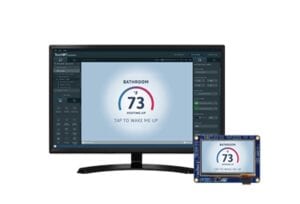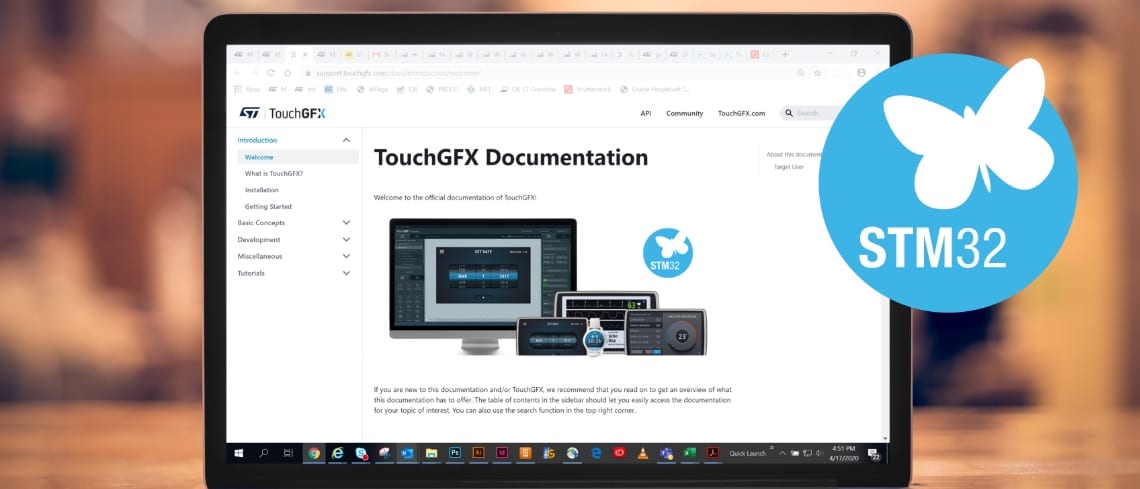To improve the accessibility of our content, please find the audio version of this blog post.
ST recently released TouchGFX 4.14, and instead of just running through the list of updates, we thought it’d be fascinating to explore how a product design and development firm, Bresslergroup, uses the framework and other ST products. We thus sat down with Brian O’Connor, Software Engineering Manager, Nicholas McGill, Senior Electromechanical Engineer, Ian Adam, Senior Embedded Software Engineer, and Sean Zarzycki, Embedded Software Engineer. The teams at Bresslergroup work on a wide range of applications, from consumer to industrial, medical, and much more. They also tackle a lot of different challenges. They may build a prototype for one client, offer consulting services for another, or carry a customer up to a manufacturer that will take care of mass production. Regardless, one constant seems to be severe time constraints as all require increasingly faster results.
Bresslergroup and TouchGFX or the Inherent Complexities of a GUI
 The new version of TouchGFX brings quite a few quality of life improvements that are important to teams like those at Bresslergroup. TouchGFX Designer now offers a SlideMenu widget for more interactive interfaces, while TouchGFX Generator supports the L8 format, for higher performances, as well as 6-bit LCDs. Moreover, the firmware renders right-to-left text faster for a better user experience. These upgrades come on the heel of TouchGFX 4.13, which decreased rendering times by up to 60 % thanks to an upgraded Texture Mapper widget. The community also welcomed TouchGFX Generator with open arms because it makes GUIs a lot more accessible. Thanks to its integration with STM32CubeMX, it can take settings from the latter and generate a large portion of the TouchGFX HAL, thus vastly optimizing workflows.
The new version of TouchGFX brings quite a few quality of life improvements that are important to teams like those at Bresslergroup. TouchGFX Designer now offers a SlideMenu widget for more interactive interfaces, while TouchGFX Generator supports the L8 format, for higher performances, as well as 6-bit LCDs. Moreover, the firmware renders right-to-left text faster for a better user experience. These upgrades come on the heel of TouchGFX 4.13, which decreased rendering times by up to 60 % thanks to an upgraded Texture Mapper widget. The community also welcomed TouchGFX Generator with open arms because it makes GUIs a lot more accessible. Thanks to its integration with STM32CubeMX, it can take settings from the latter and generate a large portion of the TouchGFX HAL, thus vastly optimizing workflows.
We were surprised to learn that Bresslergroup relies so much on the practicality and efficiency of TouchGFX Designer. As Ian, Brian, Nicholas, and Sean explained,
“Using TouchGFX Designer means that we know what things will look like on the panel very quickly. The software tool offers us the flexibility of designing a graphical interface with all the strict requirements of our User Interface and User Experience teams in mind. We can easily go back and forth, and we can rely on the tool to simulate what will appear on the final device.”Bresslergroup also explained that in a lot of projects, many underestimate the work that goes into a GUI. Too often, engineers work on the hardware implementation of a display but fail to anticipate the complexities inherent to an intuitive and friendly interface. As a result, the teams at Bresslergroup use TouchGFX Designer for the majority of the design cycle, only to switch to the code itself when it’s time to optimize the application.
Bresslergroup and ST Products or the Importance of Jumpstarting a Project
Bresslergroup explained how they use other ST products in their design, hoping to share their experience and help engineers in similar situations. For instance, they told us that they rely on STM32CubeMX and the STM32 Hardware Abstraction Layer for a lot of their projects. As Nicholas, Ian, Brian, and Sean are often under harsh time constraints, they shared how they use all the tools that can help them get a project going faster. As they told us,
“Too often, engineers just try to do everything from scratch, which can lead to massive delays. In Bresslergroup, we rarely build from the ground up. Instead, we use ST utilities, we breadboard with Nucleo boards, and utilize ST MEMS sensor libraries. We also appreciate the ability to start with a high-performance STM32 MCUs and easily work our way down to what we really need. By jumpstarting a project, we can focus on features and products that distinguish us from the competition.”It was fascinating to learn that Bresslergroup not only uses STM32 or TouchGFX, but our power devices, our gas gauges, our analog-to-digital converters, and many of our sensors. Their teams appreciated Altium’s support for our components, making the process of designing a PCB layout far more straightforward. Their engineers are also enjoying features like the unique machine learning core in some of our inertial sensors, which ensures they can offer features such as fall detection while keeping the power consumption at a minimum. They also shared how using secure boot update and secure firmware update libraries ensured they could provide the security necessary for a medical device that would be operating in a sensitive environment.
